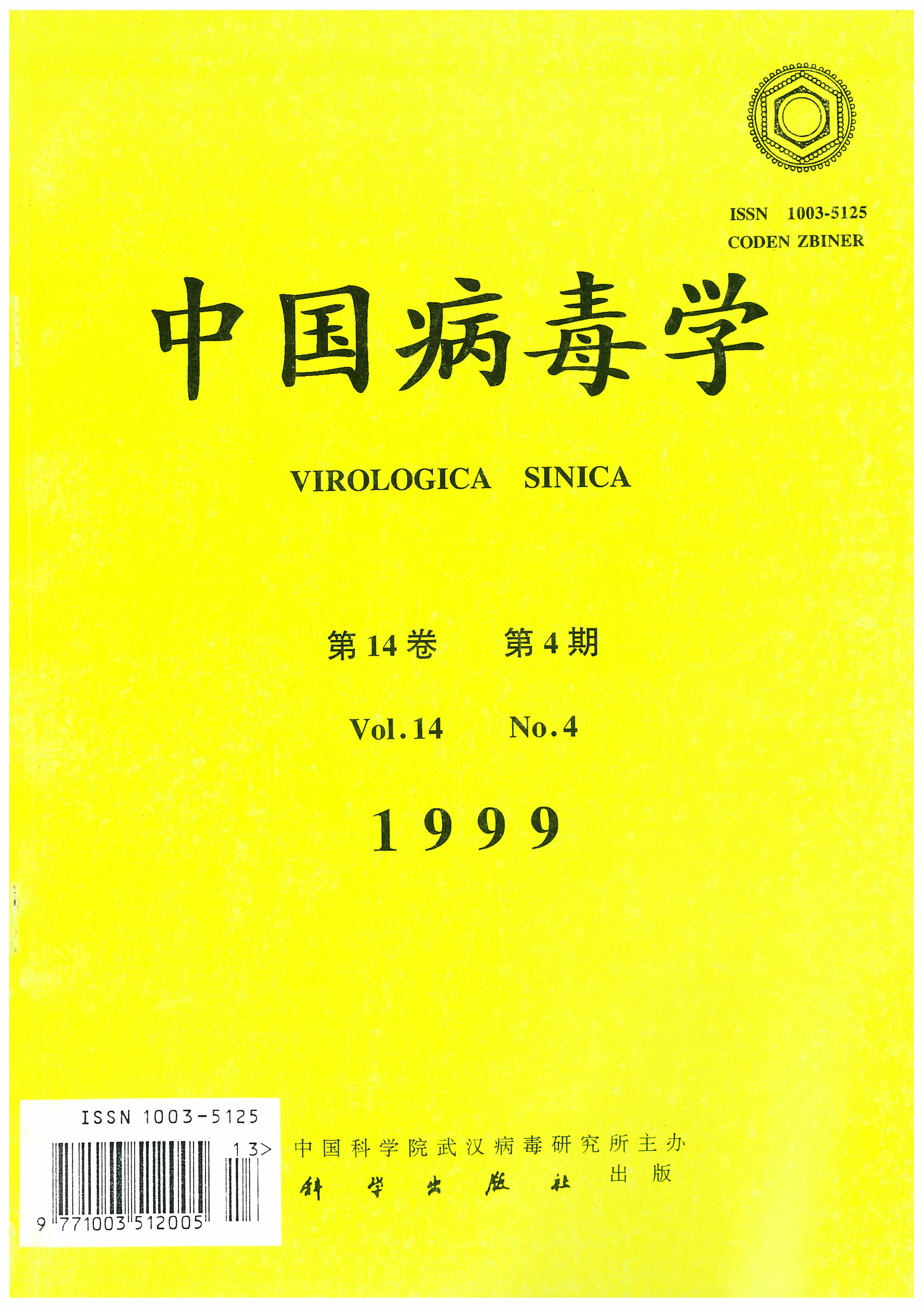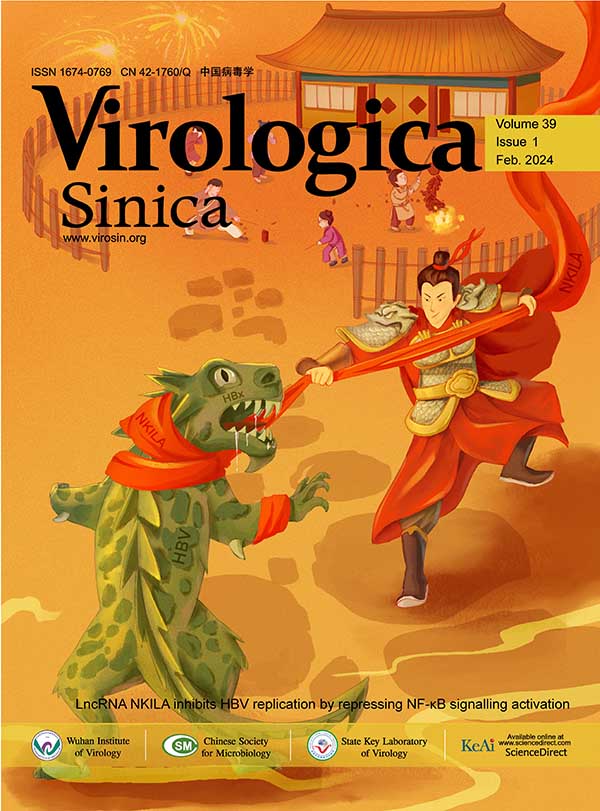E1A gene of adenovirus is an apoptosis-inducing gene and E1B gene of adenovirus is anapoptosis-inhibiting gene. The former one was cloned into adenovirus transfer vector pCA13 under the control of HCMV IE1 promoter, which resulted into transfer vector pCAE1A. PlasmidpCAE1A and pBHG11, which includes almost all the adenovirus genome but E1 region and E3 region were deleted, were cotransfected into 293 cell line. After 7-10 days, recombinant virusv5Ad4(E1B- E3- ) was obtained. v5Ad4 was used to infect A549 cell line. The results showedthat v5Ad4 can kill and lysis tumor cells. In the normal cells, v5Ad4 didn' t show visible cytotoxicity effect.
To investigate the relationship between EBV infection and genesis of gastric cancer,PCR, PCR-SSCP assay and direct in situ PCR technique were performed on samples of gastricmucoma damages; EBV infection rate was 30. 1 % in 166 samples; EBV was scattered in tissuesand roughly in nucleuses. p53 gene mutation rate was 54. 5% in 66 samples. In contrast, p53gene mutation rate was 75% in EBV-positive samples (21/28), but 39. 5 % in EBV-negative ones(15/38). The results suggest that EBV is infectious for gastric mucoma cells, p53 gene mutationis common in gastric mucoma pathological changes, EBV infection has high correlation with p53mutation, and is of importance during the genesis of cancer
Retroviral vector expressing antisense RNA complementary to HBV preS/S (antisenseS) was used to transduce human hepatoblastoma cell 2. 2. 15, which was trans fected with HBVDNA and can express HBV markers. The results showed that the inhibitory effects of antisensegene transfer mediated by retroviral vector antisense-S on the expression of HBV antigens appeared as early as on day 3 after transduction, reached peak level on day 5, and persisted at leastfor 11 days. The inhibitory rates of HBsAg and HBeAg in the 2. 2. 15 cells by antisense-S were71% and 27% on day 5 after transduction, and in comparison to blank or sense-S, the inhibitoryeffects of antisense-S were highly significant (P0.01 ). The viability of transduced 2. 2. 15 cellswas not affected as indicated by MTT assays. The results demonstrated that retroviral vectorscontaining antisense gene can inhibit HBV, and the antisense retroviral vectors may be potentiallyuseful for anti-HBV gene therapy.
Two groups of primers were designed according to the gene backgrounds of prototype
virus of HTN and SEO serotypes and corrected by co mputer.One group of primers was used to
elone entire S gencane segment and partial S genome segment with respect to N.terrmnal,n 1
two cloned genes were fusionally expressed and non-fusionally expressed by 27 system .The non
fusionally expressed products whose working co ncentration were 1:10 000 presented a good bi0_
logical activity though their yields were lower than the fusionally expressed products.The other
group of primers was used to establish a meth0d of RTPCR to detect RNAs of 37 virus isolates of
HFRSv 2 positeve standard viruses and 5 negtive controls. On comparision with that of
cELISA,the detecting rates of two m ethods were 100% and 84.6% respectively,the co incidental ratewas 84.6% whilethefoiT~1er had 15.4% higher sensitivitythan thelatter.Thetyping
method of RFLP was set up by digesting the PCR products of 20 virus isolates with Ras I and
HindUl resulting that 9 OUt of the tot81 were HTN.8 were SEO aM 3 were n0t determined re
spectively.The same 20 viruses have been previoushy typed using serotyping method resulting
tha t only 11 could he typed successfully.showing a high co nsistency with that of RTPCR-RFLP
method and a 30% lower typing etficiency than the latter.
For studing the structure and characteristic of nucleoprotein (NP) of Seoul virus R22strain, which is the seed virus of HFRS candidate vaccine, the NP gene coding region of the R22S segment was amplificated by RT-PCR and then cloned it into pET-3a expression plasmid. Se-quence assay showed that the NP gene contains 1290 nucleotides, which has homology of 96. 2%with well known Seoul virus (SR-11 ) and 71. 0% with Hantaan virus (76-118). These resultscoincide with previous Serological testings. The cloned NP gene has been transformed into E. coliBL21 and it could give a high expression when induced by IPTG. Western blot and ELISA assayof the purified products showed that expressed NP only reacted with NP-specific MAbs A35 and3D9, but not with G2-specific MA 3D8. The expressed NP can be used as a specific antigen forclinical diagnosis.
The production of tumor necrosis factor alpha(TNF-a)induced by human herpesvims
7(HHV一7)G1asgow strain and Nanjing loca1 strain YY5 and HHV一6 GS strain in umbilica1 cord
and pheripheraI blood mononuclear cells cultures was studied by means of biologicaI activity assay.
It was observed that HHV.7 is another strong inducer of TNF.q. HHV.7.infected cultlJre~
reached the maximal1eveI of TNF.q at 3 to 4 days postinfetion。which is later than that of HHv_
6(2 days postinfection).Compared with HHv.6,the amounts of TNF.a in HHV一7一infected cul
tures are smaller at 24 h postinfetion(P0.05),but the amounts of them are alI higher than
that of uninfected cells(P0.05),and there is no diference between G1asgow and YY5 strain
(P0.05).These results indicated that HHV一6 and HHV一7 can exert immunomodulatory by
stimulating the CBMCs to produce TNF-a。
In order to investigate the genomic organization of the single-nucleocapsid nucleopolyhedrovirus (SNPV) of Buzura suppressaria (BusuNPV), the BamHI-H fragment located at mapunits (mu)81. 6-83. 6 of the viral genome was sequenced. The fragment contained two partialand one complete open reading frames (ORFs) representing the 5' end of a p47 gene, a cathepsingene and the 3' end of a p74 gene. Sequence analysis futher revealed that these ORFs have thesame conserved motifs and gene structure as those observed in their homologues from other baculoviruses. The genomic arrangement of the ORFs in the BusuNPV BamHI-H fragment is verydifferent from the arrangement of their homologues in the genome of Autographa californica mutiple nucleocapsid (M) NPV.
An isolate of rice stripe virus (designated as RSVYL) was purified. The particlesshowed to be pleomorphisms under electron microscope, mainly branched filamnts of about 80-250 nm in length and abeut 8 nm in width. There are also some open circular filaments of 3nm and 8 nm in width, and some filaments of 13 nm in width and 130-190 nm in length.The basic morphism of RSV particles should be filaments of 3 nm in width and various length.By SDS-PAGE analysis, the molecular weight of disease-specific protein (SP) encoded by vRNA4 was 19. 9 kDa and tha of coat protein (CP) encoded by vcRNA3 was 33. 6 kDa. Whennucleic acid extrcted from the purified RSV was electrophoresed under nondenaturing condition, the she of four dsRNAs(designated as dsRNA1-4 in order of decreasing size) was 4. 9106, 2. 7106, 2.0106 and 1. 7106 Da, respectively, and that of four ssRNAs (designated as ssRNA1-4 in order of decreasing size) was 3. 0106, 1. 2106, 0. 9 106 and 0. 8106 De, respectively. A fifth Segment with a size of 0. 58106
The infectious spleen and kidney necrosis virus (ISKNV), derived from diseasedSiniperca chuatsi, was identified that (1 ) the virus caused ISKNV disease when challenginghealthy Siniperca chuatsi by four ways: intramuscular inoculation, intraperitoneal inoculation,wounded and bath exposure and oral inoculation; (2) the virus infected healthy Siniperca chuatsiunder 25~34℃ and the optimum temperature for infection was 28~30℃; (3 ) Microptenussalmoides was susceptibility for the virus, Oreochromis niloticus, Ctenopharyngodon idellus,Ophiocephalus argus and Lates calcarifer are not the host of ISKNV.
With white spot syndrome virus (WSSV) isolated from disease shrimp Penaeus chinensis, some of freashwater prawn and crabs: crayfish Cambarus clarkii, Macrobrachium rosenbergii, Macrobrachium nipponensis,Eriochier sinensis, Sinopotamon yangtsekiense were selected to be artificially infected. The result shows that only Cambarus clarkii can be infected byWSSV. The average mortality of three different dose groups (Group 1, 2, 3) was 94 % during 12days after injection. Intact viral particles can be seen from the hemolymph of dead or diseasedcrayfish using TEM negative staining, the shape of virion and their morphogenesis in host cell arequite similar or identical to the WSSV isolate. Hybridization in situ technique was used to confirm the reliability of the experiment. The result can be repeated using diseased Cambarus clarkiito infect the same kind of crayfish, it suggests crayfish Cambarus clarkii can be used as a goodmodel for the further study of WSSV.
By the polyacrylamide gel electrophoresis (PAGE) and thin-layer scanning, the esterases (EST) of the third instar larvae of the Helicoverpa armigera were investigated in qualityand quantity after infection with nuclear polyhedrosis viruses (NPV). The changes in sort andcontent of hemolymph EST were examined at six hours postinfection and the numbers of ESTbands were from more to less as develop and infective time in larvae. The varies in EST patternbetween infection and control were not significant but the content of each band and the accumulation of EST were obvious. According to the changeable regularity in EST content of zymogram,the total and single content in diseased larvaes always gradually decreased with passages of infective time but in the healthy larvaes had no distinct changes. The results demonstrated that the infection with NPV could affect the EST metabolism in larvae hemolymph, and the metabolicchanges may show the infective level and extent, there fore it had indicated function.
The serological relationships of several kinds of peanut viruses were analyzed by usingtechniques of agar diffusion test and ELISA. The results show that, among four main kinds ofviruses that infect peanut (PSV, PStV, TS and CMV), PSV, TS and PStV have strong infectingabilities, but CMV has poor infecting ability. TAV, TS-13, Mi and TS-7 have good relationshipwith each other, but CA is different from them

















